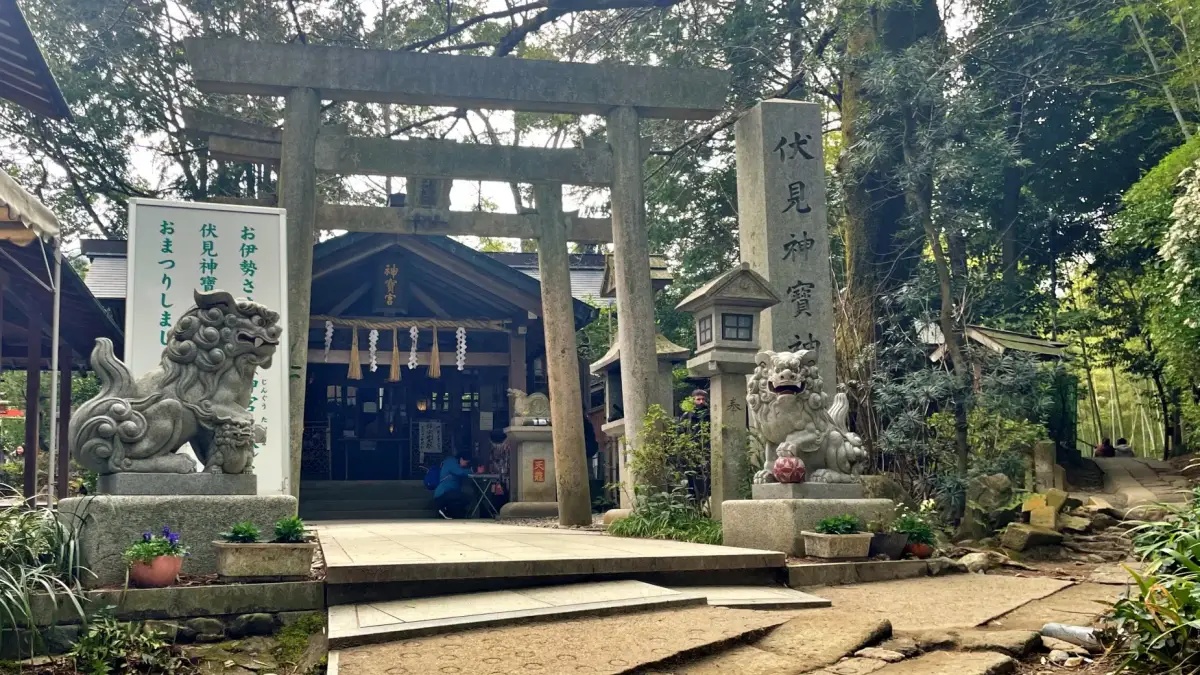This time, we will introduce the power spot “Fushimi Kandakara Shrine” on Mt. Inari, which enshrines “Princess Kaguya” and “Ryujin”, which may connect you with the universe.

Fushimi Kandakara Shrine, located halfway up Mt. Inari, is a shrine that enshrines Amaterasu Omikami and Inari Daimyojin, and enshrines ten kinds of sacred treasures.
The shrine was founded in the Heian period, and was once enshrined near the summit of Mt. Inari, where it was deeply worshiped by Emperor Uda and other members of the imperial family, but it declined in the medieval period due to political upheavals, and was moved to its current location in 1957.
On the grounds, there are enshrined dragon gods such as Ryuzusha, which is said to be the “God of Clothes,” the Eight Great Ryu Okami, and the Hakuryu Okami. It is also a power spot that is home to Iwasaka, which is said to be the birthplace of the Tale of the Bamboo Cutter, and Sokotsu Iwato Shrine, which has blessings for business and entertainment.
Overview of Fushimi Kandakara Shrine
Official name: Fushimi Kandakara Jinja
Common name: Shinpo-san
God enshrined: Amaterasu Omikami
Deity enshrined together: Inari Daimyojin
Founded: Early Heian period
Reconstruction: 1957 (Showa 32)
At the entrance to Fushimi-Kandakara Shrine, there is a stone plaque that reads “Fushimi-Kadakara Shrine History overview”.
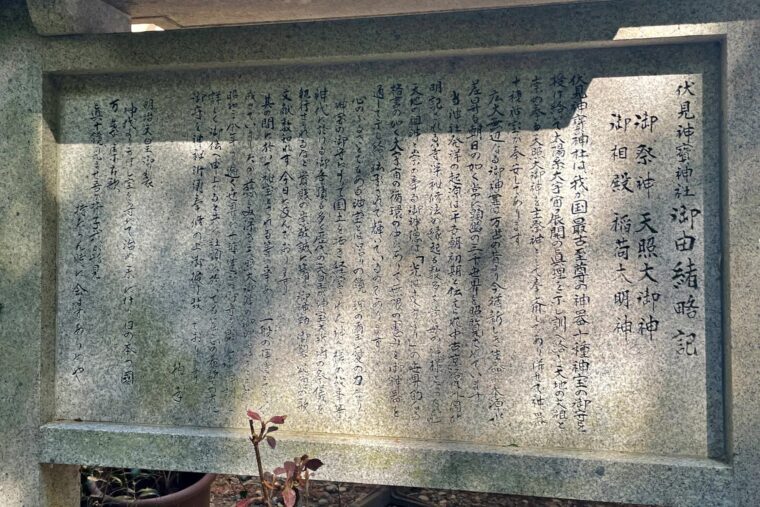
Fushimi-Kadakara Shrine History overview
God enshrined: Amaterasu Omikami
Deity enshrined together: Inari Daimyojin
Fushimi Kadakara Shrine is dedicated to Amaterasu Omikami, who is worshiped as the ancestor of heaven and earth, who bestows the protection of Japan’s oldest and most sacred treasures, and who teaches us the truth of the expansion of the solar system and the cosmos. In addition, ten types of sacred treasures are enshrined here.
The vast and limitless divine spirit has been the origin of new life since time immemorial, and has always been observing the three thousand manifest worlds like the rising sun.
The origin of this shrine is said to be in the early Heian period, and there are many auspicious rituals such as those described in ancient Kyoto and other regions, and it is revered as the god of benevolent mothers and the ancestral god of heaven and earth. The divine virtue shines in the cycle of the universe, as the world-famous saying “Light comes from the East” shows us the infinite blessings through the divine treasures and passes them down.
The sacred treasures that are the home of the soul are the mirror of enlightenment, the bead of reason, and the power of love.
Stories of the gods who opened up and managed the country with the amulet of sacred treasures, and other sacred events in the Age of the Gods.
Successive emperors performed rituals of the Great Prayer for Divine Treasures, and the shrine was deeply revered, and even today there are countless books of sacred edicts and odes.
During that time, it was considered a hidden treasure, and it was no longer possible for the public to worship it, but out of respect for the divine will of the merciful Amaterasu Omikami, Since 1945, we have revealed the ten kinds of sacred treasures to the world.
At the same time as we pass on the divine precepts in detail, we also give amulets at the head of the shrine to those who wish to do so, after performing mystical prayers.
Waka poems composed by Emperor Meiji
Protecting the treasures received from the age of the gods, the kingdom of Japan has come to rule.
The ten kinds of sacred treasures mentioned in the summary of the history are the “Amatsu Shishi Mizuta Karatokusa” written in “Sendai Koji Honki”, which is considered to be one of the Shinto classics, and are the ancestral deities of the Mononobe clan. These are the 10 treasures that Nigihayashi no Mikoto was given in heaven.
According to the Tenson Honki, Volume 5 of the Sendai Koji Honki, when Nigihayahi no Mikoto was about to descend to the earthly world, he was given ten sacred treasures by the ancestor of Tenjin as a sign of being the son of Tenjin.
Furthermore, the ten kinds of sacred treasures are also mentioned in “Kiki” (collective name for the Kojiki and Nihon Shoki) and “Kogojui”, and after Nigihayahi no Mikoto presented them to Emperor Jinmu, the three kinds of sacred treasures were created.
These sacred treasures are powerful enough to influence the rise and fall of a nation, as stated in the historical abbreviation, “In the circulation of the universe, infinite blessings are shown through the sacred treasures and handed down and shine.”
Ten types of sacred treasures
- Okitsu Kagami
- Hetsu Kagami
- Yatsuka no Tsurugi(Eight-handled sword)
- Ikutama
- Makaru Kaheshi no Tama(Death return ball)
- Tarutama
- Chikaheshi no tama
- Orochi no hire
- Hachi no hire
- Kusagusa no mono no hire
Main shrine/worship hall
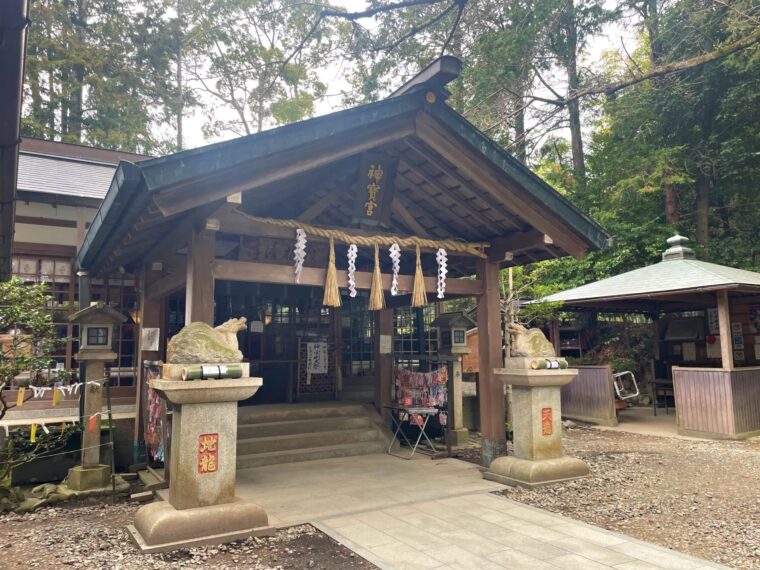
Amaterasu Omikami and Inari Daimyojin are enshrined in the main shrine, and ten kinds of sacred treasures are enshrined there. In the foreground, there are stone statues of “Jiryu” and “Tenryu,” who are said to be the followers of Amaterasu Omikami.
The dragon god’s main role is to protect the earth as a messenger of God. Broadly speaking, there are two types: the “Earth Dragon”, which activates the earth’s ley lines (dragon veins), and the “Tenryu”, which protects the heavens and supports people.
Tenryu have different support abilities depending on their color, and depending on your wish, a dragon of the color that matches what you want to do will be attached to you.
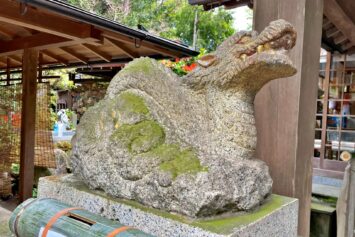

The one on the left is the “Jiryu” and the one on the right is the “Tenryu”, and they hold the “Nyoi Hoju” which has the power to make any wish come true.

On the beam near the ceiling of the worship hall is a plaque with the words “Rokon Shojo” written on it. The six roots are the human senses of sight, hearing, smell, taste, and touch, plus the mind, and are prayer words (suggested to the gods) that have the meaning of keeping one clean with divine virtue when faced with defilement.
“God of Clothes” Ryuzusha
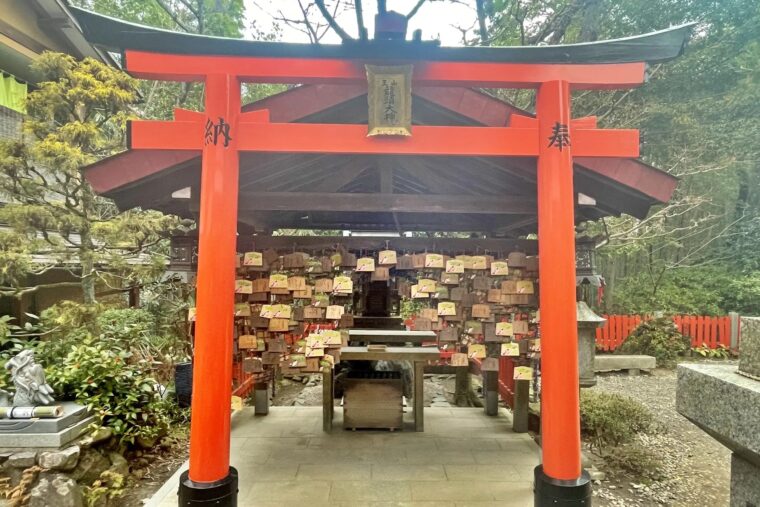
To the left of the main shrine is Ryuzu Shrine, which enshrines Ryuzu Okami, the god of the landowners of Mt. Inari. “Ryuzu” is also the name of the metal fitting on which the weft threads are hung on Nishijin-ori looms, so it is also said to be the “god of clothing.”
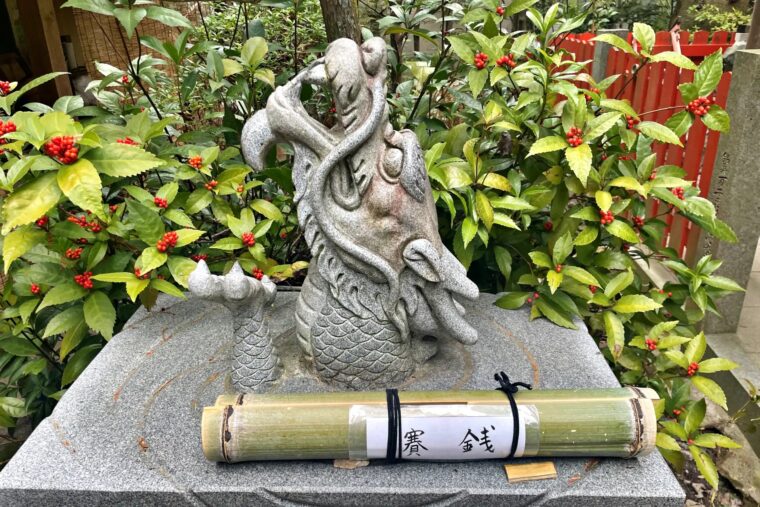
Next to the shrine is Ryutou-san (a statue of a dragon with its head and hands sticking out of the water). It is said that if you gently stroke its head and pray to it, your wish will come true.
Iwasaka, “The Birthplace of the Bamboo Cutter Story”
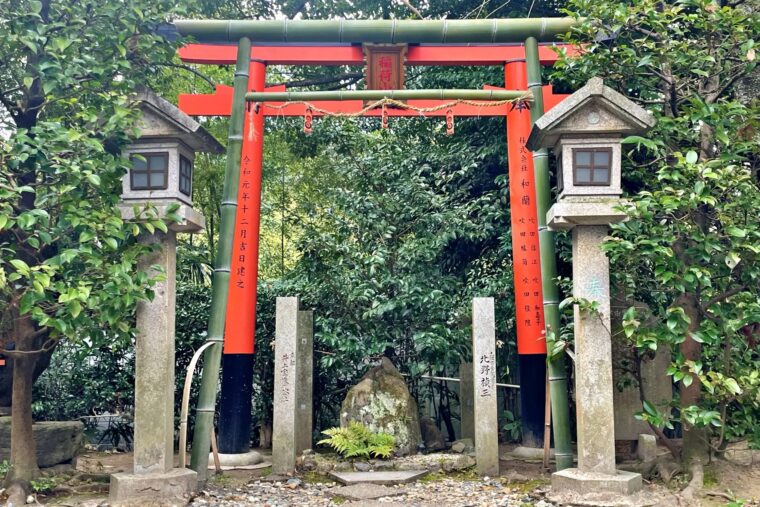
The bamboo torii shrine located at the innermost part of the shrine grounds is the birthplace of the Tale of the Bamboo Cutter, and enshrines a bamboo shoot-shaped advent stone called “Takenoko-ishi.”
As this is the birthplace of The Tale of the Bamboo Cutter, there are many bamboo thickets in this area. When you leave Fushimi Kampo Shrine, the direction of the mountain on the left is called “Takenoshita Michi” and you can see a beautiful bamboo thicket.
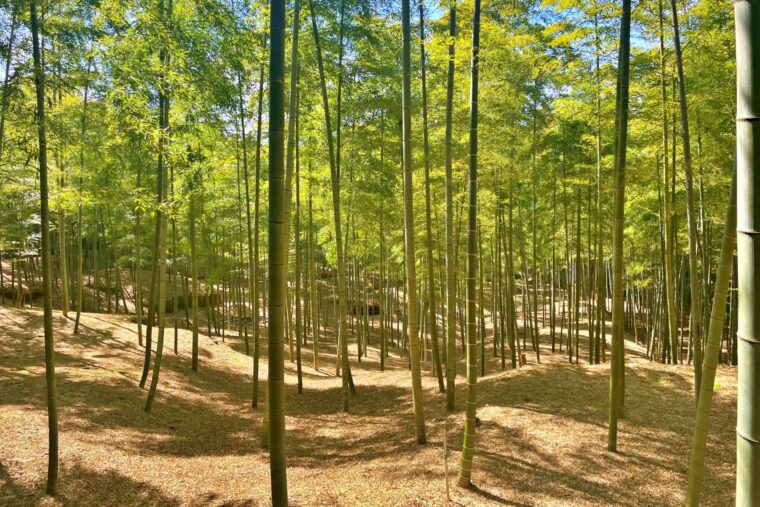
In a straight line from Iwasaka towards Mt. Inari are Manomine (Kada Shrine Shrine, which enshrines Ise Okami) and Ichinomine (Ueno Shrine, which enshrines Suehiro Okami). For this reason, it is said to be the place where the spirit of the gods gathers the most on Mt. Inari.
Sokotsu Iwatosha
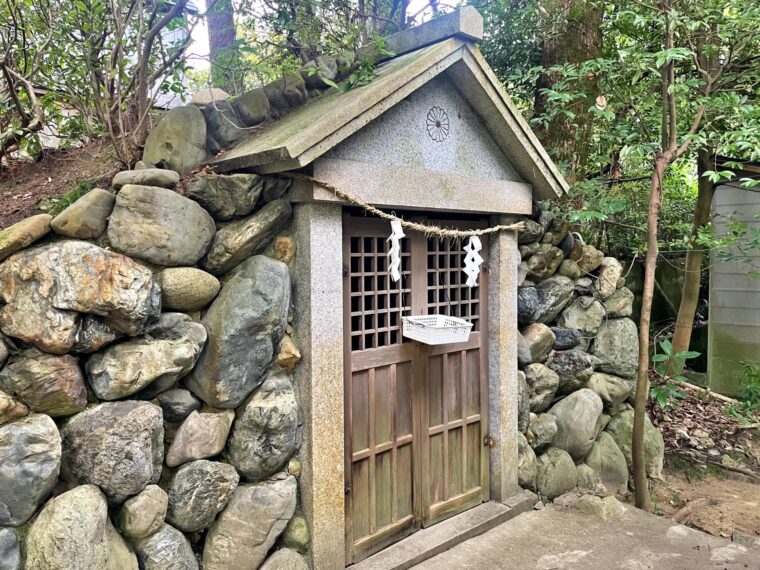
Sokotsu Iwato Shrine is located on the north side of Iwasaka, just down the stairs on the south side. The shrine with the chrysanthemum emblem is a cave modeled after “Amanoiwado,” and Omiya Nome no Mikoto is enshrined inside.
Omiya Nome no Mikoto is the same deity as Omiya Nome no Okami, which is enshrined in the main shrine of Fushimi Inari Taisha. Business owners and people in the entertainment industry believe in this shrine as it is believed to bring good luck to business and the arts.
Eight Great Dragon King Gods/Gondayu-daijin/Hakuryu-daijin

On the north side of the stairs of Sokotsu Iwato Shrine, there are mounds dedicated to the eight great gods of Ryuo, Gondayu, and Hakuryu.
The Eight Great Dragon Kings is a general term for the eight dragon gods that protect Buddhism in the Lotus Sutra, and is said to be the great god that embodies the deity of creating the universe, nurturing all things, fulfilling great wishes, and saving all spirits.
Gondayu Okami is enshrined at Kojinmine (Tanaka Shrine) as one of the five sacred shrines of Mt. Inari. Gondayu Okami is another name for “Okuninushi-kami = Ōki-no-kami” and is also commonly called Daikoku-sama.
Hakuryu Okami is a god who works as a follower of Toyotama Hime no Mikoto, who rules the dragon god world, and is a god who moves freely in the heavens and earth, causing “flows” and controlling the weather and ocean currents.
In addition, the white dragon is said to have the fastest flight speed among dragons, and because of this, it is said to bring about early fulfillment of wishes, improved luck, good fortune, and good luck.
Furusha
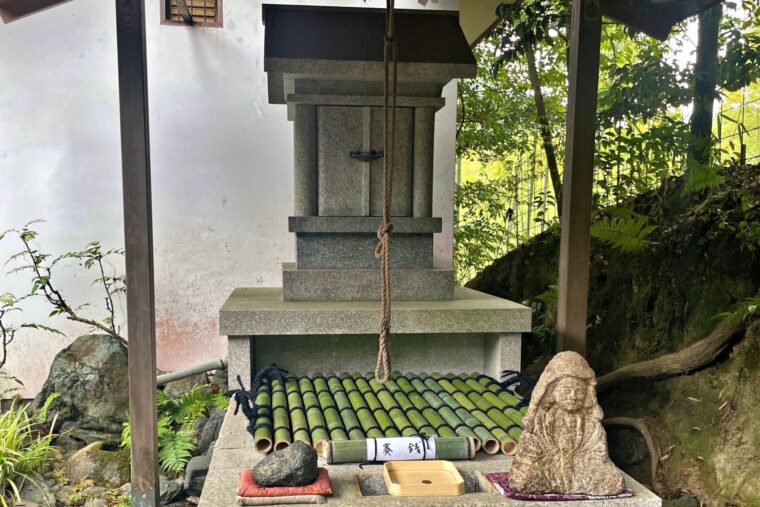
The shrine located on the right side of the main hall is Furusha, where Shiragiku Omikami (Tentadama no Mikoto), Shirahige Omikami (Sarutahiko no Mikoto), and Hakuryu Omikami are enshrined. It used to be located on Gojo-dori Street in Kyoto, and was apparently relocated to this location when the road was expanded.
There is a well in front of the shrine, and it is said to be connected to Yamato Furu Shrine (Ishigami Shrine in Tenri City, Nara Prefecture) through an underground water vein. Legend has it that white cloth washed up in this area, which is why it was named Furusha, which means “the cloth stays here.”
In front of Furusha there is “Omokaru Stone”.
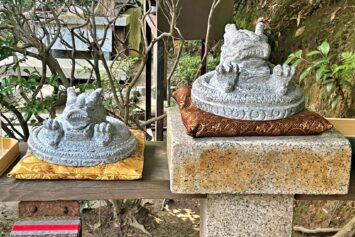
How to tell fortunes using Omokaru stone
- Bow once
- Make a wish and hold a wishing statue (a stone shaped like a dragon)
- As a result, if you feel lighter, your wish will come true.
How to get to Fushimi Kandakara Shrine
To get to Fushimi Kandakara Shrine, go up the stairs at the back of the main hall from Okumiya, pass through the Senbon Torii gates, and head to the Okushahohaisho.
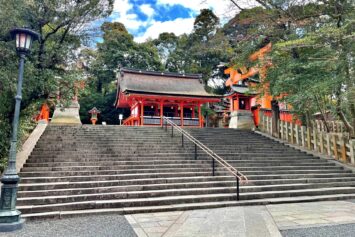
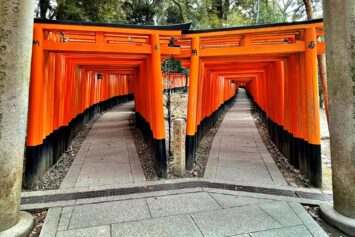
Further up the mountain path with a torii gate, you will see a sign for “ Kandakara Shrine” on your right. From here it will be a mountain path, but after walking for about 5 minutes, you will see the torii gate and guardian dog of Fushimi Kampo Shrine on your left.
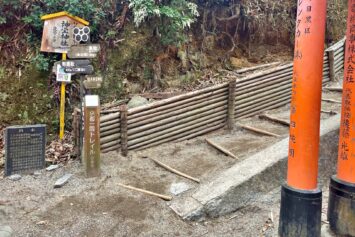
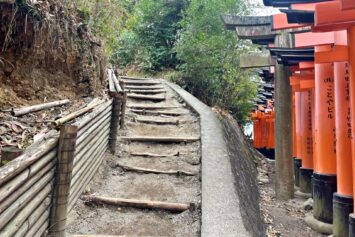
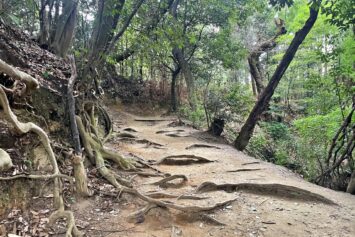
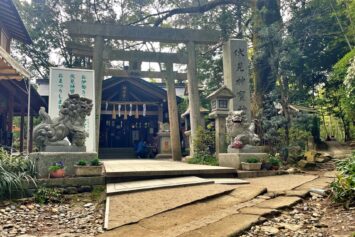
It is located behind the main shrine building of the Okushahohaisho, in the direction of Mt. Inariyama Mikamine.
In conclusions
This time, we introduced “Fushimi Kandakara Shrine” in Mt. Inari, which enshrines “Ryujin” and “Kaguyahime” and feels connected to the heavenly world.
“Fushimi Kandakara Shrine” is located off the tourist route, so it is relatively quiet and surrounded by nature such as bamboo groves.
“Fushimi Kandakara Shrine” has Manomine (Kata Shrine, which enshrines Ise Okami) and Ichinomine (Ueno Shrine, which enshrines Suehiro Okami), which lie in a straight line towards Mt. Inari. For this reason, it is said to be the place where the spirits of the gods gather most in Mt. Inari.

